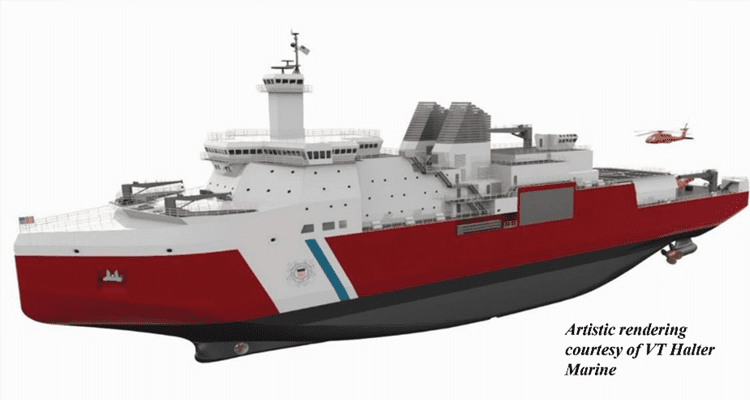
ARLINGTON, Va. — The coronavirus pandemic and the complexity of building the first U.S. heavy ice breaker in nearly 40 years were among the reasons for another year’s delay in the expected delivery of the Polar Security Cutter, Coast Guard Commandant Adm. Karl Schultz said Jan. 12.
“We have publicly stated that the delivery date for Polar Security Cutter number one is going to be May 2025, so it slipped about a year,” Schultz told an audience at the Surface Navy Association’s annual symposium in Arlington. Originally, officials thought the PSC program of record for three heavy ice breakers, with two already fully funded, would begin rolling vessels starting in 2023.
“It’s just a complex thing. COVID really layered in some challenges there,” Schultz said, adding that the United States hasn’t built a heavy ice breaker “in the better part of four-plus decades.“ He noted the new vessel requires “complex steel work that shipyards don’t necessarily do every day.” There also were some issues with international partnerships.
The operational U.S. polar icebreaking fleet currently consists of one heavy polar icebreaker, Polar Star, built in 1976, and one medium polar icebreaker, Healy, which is also used for polar research.
“It’s tough to be an Arctic nation when you have one heavy [ice] breaker that’s almost 50 years old and one medium breaker that’s really science,” Schultz said.
Since the 2013 U.S. National Strategy for the Arctic Region described the United States as “an Arctic Nation with broad and fundamental interests,” the Coast Guard, Navy and other armed services have developed strategies for operating in the northern polar region. Melting sea ice has turned the top of the world into a potential economic, diplomatic and military flash point as sea lanes have opened up increased commercial sea lanes in summer to large cargo ships, fishing fleets, oil and gas exploration and tourism.
“I think the goal right now would be to continue to work with the Navy Integrated Project Office, continue to work with the shipbuilder, finish up the complex, detailed design and start cutting steel here in 2022,” Schultz said, adding ”I think if we stay at that track line, I am guardedly optimistic we’ll take delivery of that ship in 2025 and be off to the races.”
In the meantime, Schultz said the Coast Guard has been sending its larger cutters into the high latitudes to participate in exercises with partners like France, Canada, Denmark and the United Kingdom.
“It’s one of those places where very few of the Arctic nations, outside of Russia have a whole lot of capacity, Schultz said, noting that Russia currently holds the chairmanship of both the Arctic Council and the Arctic Coast Guard organization.
- Shall We Play a Game? Winning Isn’t the Point, Experts Say - April 5, 2023
- U.S. Goal: Maintaining Extended Presence in Arctic’s Harsh Environment - April 4, 2023
- Joint, Combined Exercise Shows Marine Littoral Regiment Idea is on ”Right Track’ - February 24, 2023






